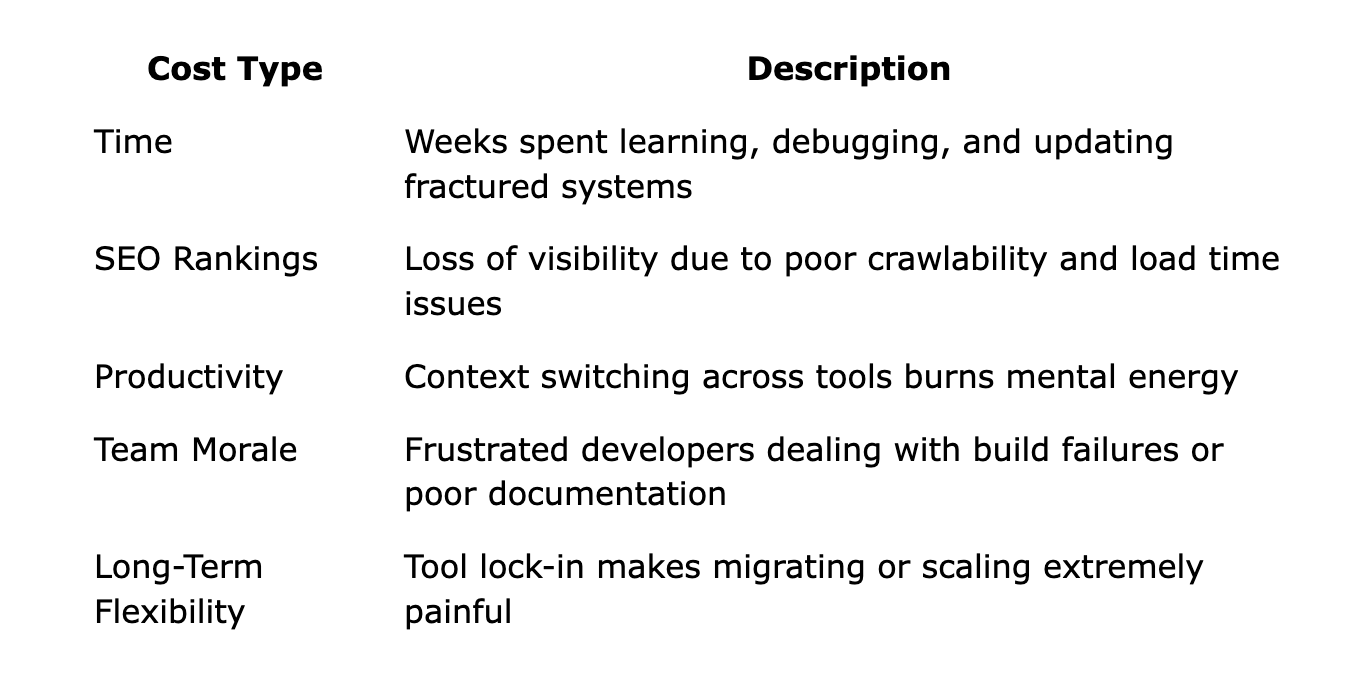- Home
- Frontend Fragmentation: The Hidden Cost of Too Many Tools (Vue, NuxtJS, and Beyond)
Frontend Fragmentation: The Hidden Cost of Too Many Tools (Vue, NuxtJS, and Beyond)

9 June, 2025
A Double-Edged Sword
In today’s web development landscape, frontend developers are spoiled for choice. Frameworks like Vue.js, NuxtJS, React, Next.js, Svelte, Astro, Remix, and countless others offer a dazzling array of features, performance boosts, and productivity tools. The ecosystem is booming, pushing boundaries and innovating faster than ever.
However, this rapid growth comes with a darker side: frontend fragmentation. As the number of tools increases, so do the problems. Compatibility issues, steep learning curves, context-switching fatigue, and team inconsistencies are becoming all too common.
This post dives deep into the state of frontend fragmentation, why it's happening, the consequences, and what we can do to regain some control. It’s a must-read for developers, team leads, and tech decision-makers aiming to build scalable, maintainable frontend applications in 2025 and beyond.
What is Frontend Fragmentation?
Frontend fragmentation refers to the growing divide in tools, practices, frameworks, and philosophies used to build modern UIs. Unlike back in the day, when HTML, CSS, and JavaScript were all you needed, today’s frontend development involves decisions around:
- Framework (Vue, React, Svelte, etc.)
- Meta-framework (NuxtJS, Next.js, Astro)
- State management (Pinia, Redux, Recoil, Vuex)
- Styling (TailwindCSS, CSS-in-JS, SCSS, plain CSS)
- Build tools (Vite, Webpack, esbuild)
- Component libraries (Vuetify, Chakra UI, Radix, Bootstrap)
- Type systems (TypeScript vs JavaScript)
Each decision spawns yet more sub-decisions. The result? A fractured ecosystem with diminishing cohesion.
Why Frontend Fragmentation Happens
1. Open Source Innovation (and Overload)
The rise of open-source culture fuels innovation, but it also overwhelms developers. New frameworks and libraries emerge almost weekly. Each promises to solve a niche problem “better,” but few play nicely with one another.
2. Hype-Driven Development Culture
Developers gravitate toward “shiny new things.” Framework churn is real, and staying current feels like running a treadmill you can’t step off. While excitement drives evolution, it often leads to decision fatigue and tech debt.
3. The Complexity of Integrating APIs, CMSs, and AI
Modern frontend stacks also have to interface with headless CMSs and AI tooling. As discussed in this blog on unlocking the power of headless CMS, decoupling content management from the frontend creates freedom, but also introduces architectural complexity.
Similarly, integrating AI-assisted dev tools (as covered in the 2025 AI tools for software development guide) into fragmented stacks requires careful orchestration, often across multiple layers of the tech stack.
Problems That Arise from Frontend Fragmentation
1. Developer Onboarding Becomes a Bottleneck
New hires must learn your specific combination of Vue + Nuxt + Tailwind + Vite + Pinia—often under pressure. If they came from a React + Redux background, the ramp-up curve is steep.
Result: Lost productivity and misaligned code styles.
2. Inconsistencies Across the Codebase
Without strict conventions, teams quickly mix:
- Composition API and Options API in Vue
- Tailwind with scoped SCSS
- Inline styles with utility-first approaches
Code becomes harder to maintain and reason about. This technical inconsistency eventually leads to bugs, performance drops, and SEO problems.
3. Build Failures, Integration Issues, and CI/CD Nightmares
Mixing modern tools like Vite with legacy Webpack plugins or trying to SSR a hybrid NuxtJS/Astro project? It’s a recipe for frequent build breaks. DevOps pipelines become fragile, and deployments become unpredictable.
4. SEO and Performance Penalties
A poorly optimized Vue or NuxtJS setup can significantly affect SEO:
- Slow LCP from excessive hydration
- Broken routing and dynamic pages that Googlebot can’t crawl
- Bloated bundles with redundant libraries
As emphasized in our headless CMS post, SEO-first strategies rely on clean SSR, proper metadata management, and page load performance, all of which are harder with fragmented architectures.
5. Redundant Learning Curves
Every new tool requires:
- Time to learn
- Time to integrate
- Time to troubleshoot
Multiply that across all developers, and you lose weeks or even months of productive work annually.
Real-World Case: Vue + Nuxt + Tailwind + Pinia + Vite
This combo is common in 2025, yet it showcases all the fragmentation pitfalls:
- Vue 3 introduces a Composition API, which doesn’t play nicely with older code using the Options API.
- Tailwind classes clutter templates unless carefully abstracted.
- Nuxt’s file-based routing can clash with custom route logic.
- Vite’s plugin ecosystem is growing, but not all libraries are compatible.
- Pinia replaces Vuex, but many third-party components still expect Vuex patterns.
It's flexible. But is it maintainable at scale?
The Hidden Costs
Let’s break down the invisible price tags:

Strategies to Combat Frontend Fragmentation
1. Prioritize Convention Over Configuration
Use tools like NuxtJS and Next.js as they are meant to be used. Their opinionated defaults are there for a reason; embracing them ensures consistency and community support.
2. Build a Team-Centric Stack
Choose tools based on your team’s collective experience. Avoid forcing bleeding-edge tech for marginal gains. For example, do you need to use Astro + Islands Architecture if Nuxt does the job?
3. Maintain a Living Documentation
A Frontend Stack Handbook should answer:
- What frameworks are we using and why?
- What CSS strategy is standard?
- What naming conventions are enforced?
- Where are the SR pitfalls noted?
- How do we structure API integrations with headless CMSs?
Documentation improves onboarding and prevents tribal knowledge hoarding.
4. Consolidate Your Toolchain
If you’re using Tailwind and SCSS and CSS modules, streamline to one. Likewise, prefer single meta-frameworks over patching together multiple layers.
5. Automate and Audit
Use tools like:
- Bundle analyzers (e.g., Webpack Bundle Analyzer)
- Core Web Vitals monitors
- Lighthouse audits
- AI-powered code reviews (like those in this roundup of 2025 AI dev tools)
These will help you objectively measure fragmentation’s impact on performance and maintainability.
Final Thoughts
Frontend fragmentation isn’t going away. But we can tame it.
Embrace minimalism, documentation, and team-aligned decisions. Built with the future in mind, where content from a headless CMS flows smoothly into performant, SEO-friendly Vue or React apps, augmented by AI, where it saves time.
Start with a unified philosophy, and your stack will follow suit.
Ready to Rein in Your Frontend Chaos?
At Geonovation, we help digital teams navigate the complexities of modern frontend architecture. If your stack feels more like a patchwork of tools than a cohesive system, it’s time to rethink your approach.
We work with enterprises, NGOs, and platform-driven organizations to:
- Audit and streamline fractured frontend ecosystems
- Establish documentation and tooling standards that scale
- Optimize performance, SEO, and developer workflows
- Integrate headless CMSs like Drupal seamlessly into Vue, Nuxt, React, and more
Let’s bring clarity and cohesion to your digital stack before fragmentation costs you more.
Book a free consultation with our engineering leads today.
We’ll help you build a frontend that your team enjoys working in.